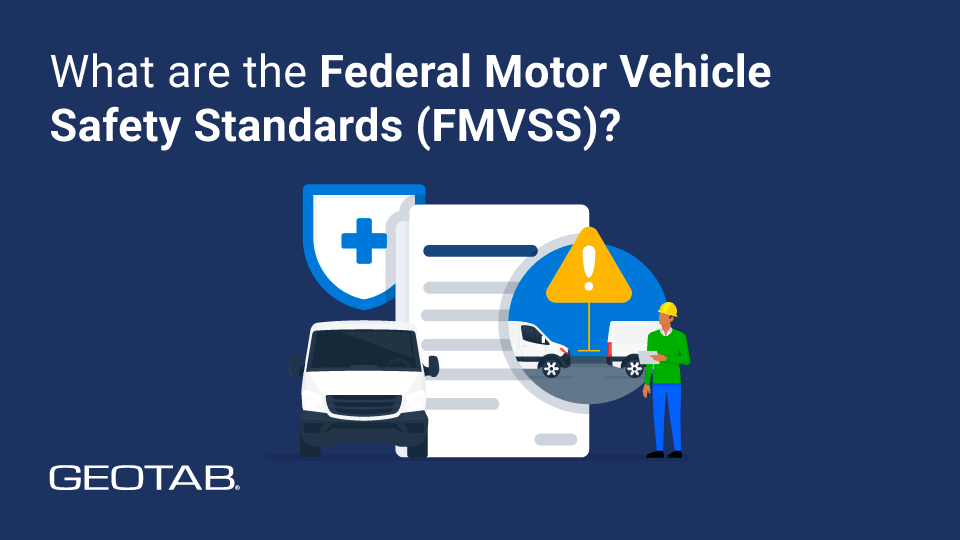What are the Federal Motor Vehicle Safety Standards (FMVSS)?
January 3, 2025
•4 minute read

Key Insights
- The Federal Motor Vehicle Safety Standards (FMVSS) is a comprehensive set of regulations established by the U.S. National Highway Traffic Safety Administration (NHTSA) to ensure the safety, performance and quality of motor vehicles and motor vehicle equipment.
Understanding the Federal Motor Vehicle Safety Standards (FMVSS) and their impact on fleet operations is crucial for fleet managers in North America. In this glossary blog post, you will learn the definition of FMVSS and their classifications, why FMVSS rules are important for vehicle safety and best practices to ensure FMVSS compliance.
What are the Federal Motor Vehicle Safety Standards (FMVSS)?
The Federal Motor Vehicle Safety Standards (FMVSS) is a comprehensive set of regulations established by the U.S. National Highway Traffic Safety Administration (NHTSA) to ensure the safety, performance and quality of motor vehicles and motor vehicle equipment. These standards are designed to minimize the risk of traffic accidents and injuries by setting minimum requirements for vehicle design, construction and performance. Canada has a similar system of national vehicle standards known as the Canada Motor Vehicle Safety Standards (CMVSS), so fleets operating in both countries should also be familiar with CMVSS.
Importance of FMVSS for vehicle safety
FMVSS regulations apply to essentially all motor vehicles in the U.S., making it vital for fleet operators to understand them and how they impact general and fleet-specific safety.
General safety
FMVSS rules play a foundational role in enhancing road safety by addressing critical areas such as crash avoidance, crashworthiness and post-crash survivability. These standards help protect drivers by ensuring all vehicles meet rigorous safety benchmarks.
Fleet-specific safety
For fleet managers, FMVSS compliance is required for regulatory adherence and is critical for operational integrity. Non-compliance can lead to increased liability, greater risk of collisions, higher insurance costs and damage to a company’s professional reputation. By ensuring their fleet vehicles meet FMVSS requirements, fleet managers can enhance driver safety, protect cargo and minimize downtime caused by collisions or vehicle defects.
What are the different FMVSS categories?
To create a comprehensive safety framework, FMVSS requirements are organized into three categories that address different aspects of vehicle safety: Crash avoidance, crashworthiness and post-crash survivability.
Crash avoidance
These FMVSS standards focus on preventing collisions by mandating high performance from vehicle systems like brakes, tires, windshield wiping, lighting and electronic stability controls. Key crash avoidance regulations include FMVSS 126 for electronic stability control systems and FMVSS 108 for lamps, reflective devices and associated equipment.
Crashworthiness
Crashworthiness FMVSS standards are designed to protect occupants during a collision by ensuring the vehicle's structural integrity and the effectiveness of its safety devices. Examples of crashworthiness rules include FMVSS 214 for side impact protection and FMVSS 208 for occupant crash protection, such as seat belts and airbags.
Post-crash survivability
These FMVSS standards minimize post-crash risks such as fire hazards or difficulty exiting a vehicle. Some of the most important post-crash survivability regulations include FMVSS 301 for fuel system integrity and FMVSS 302 for the flammability of interior materials.
Compliance with FMVSS
Role of manufacturers
Vehicle manufacturers are responsible for ensuring all vehicles they sell in the U.S. comply with applicable FMVSS. To certify compliance, manufacturers must rigorously test and document vehicle safety before making vehicles available for purchase.
Responsibilities of vehicle operators
Fleet managers also play a critical role in ensuring FMVSS compliance by maintaining each vehicle over its lifespan. FMVSS compliance for fleet managers includes conducting regular inspections, properly maintaining safety systems, training drivers on safe operating practices and keeping detailed records of vehicle compliance.
Common FMVSS compliance challenges
Understanding certification requirements
Navigating FMVSS regulations can be complex, especially for managers of diverse vehicle fleets. To ensure each vehicle type meets its specific standards, fleet managers must be familiar with FMVSS certification requirements for all vehicles and keep track of each vehicle’s compliance status. A comprehensive telematics solution can make FMVSS compliance management easier by organizing and monitoring each vehicle’s condition and maintenance schedule.
Fleet safety considerations
Fleet managers always aim to improve safety across their operations, which can lead them to add aftermarket modifications and upfits for older vehicles. These additions can make complying with FMVSS rules more complicated, making it important to partner with knowledgeable vendors to integrate aftermarket modifications and ensure proper vehicle upfitting for older vehicles. It is also useful to invest in compliance training so operators can stay up to date on FMVSS rule changes.
Specific standards for various vehicle types
Because the FMVSS has different rules for different vehicle types, fleet managers need to be familiar with the specific standards for each vehicle type in their fleet.
Regulations for commercial vehicles
Commercial vehicles like trucks must adhere to FMVSS regulations that address their unique safety needs. These rules include:
- FMVSS 121: This regulates the air brake systems of large commercial vehicles to ensure they can stop within a reasonable distance.
- FMVSS 136: This rule governs the electronic stability control for heavy vehicles, ensuring drivers can maintain control while carrying large loads.
- FMVSS 302: This regulates the flammability of interior materials in commercial vehicles to reduce the risk of fire from injuring drivers and passengers.
Standards applicable to buses
Buses have special FMVSS requirements to ensure passenger safety, including:
- FMVSS 217: This regulation concerns bus emergency exits and window retention, ensuring passengers can safely exit a bus during an emergency.
- FMVSS 222: This rule governs school bus seating and crash protection to keep children safe during transit.
- FMVSS 227: This standard for bus rollover structural integrity focuses on enhancing rollover structural integrity to increase passenger safety during a collision.
The future of FMVSS
Evolving trends in vehicle safety regulations
As technology advances, FMVSS continues to evolve to address new safety challenges. As fleets add innovations like autonomous driving systems, vehicle-to-vehicle communication and advanced driver assistance systems (ADAS), new FMVSS rules for these technologies are reshaping the regulatory landscape. This makes it important for fleet managers to follow FMVSS updates.
Anticipated changes and advancements in technology
Looking ahead, fleet managers should prepare for updates to FMVSS that incorporate:
- Enhanced cybersecurity measures: As criminals develop new ways to breach vehicle systems, the FMVSS is evolving regulations to prevent sabotage and data theft.
- Standards for electric and hydrogen fuel cell vehicles: As fleets embrace new green technologies, the FMVSS will continue to introduce special rules for these vehicles to keep drivers safe.
- New crash testing protocols for automated vehicles: Self-driving vehicles are an exciting technology, but they have obvious safety concerns. Look for the FMVSS to introduce more rigorous crash testing protocols and other special rules for autonomous vehicles.
Other Stories

What are maintenance service intervals?
April 9, 2025
5 minute read

What is a space cushion? A defensive driving guide for commercial drivers
November 13, 2024
3 minute read

What is a safe following distance?
October 8, 2024
5 minute read